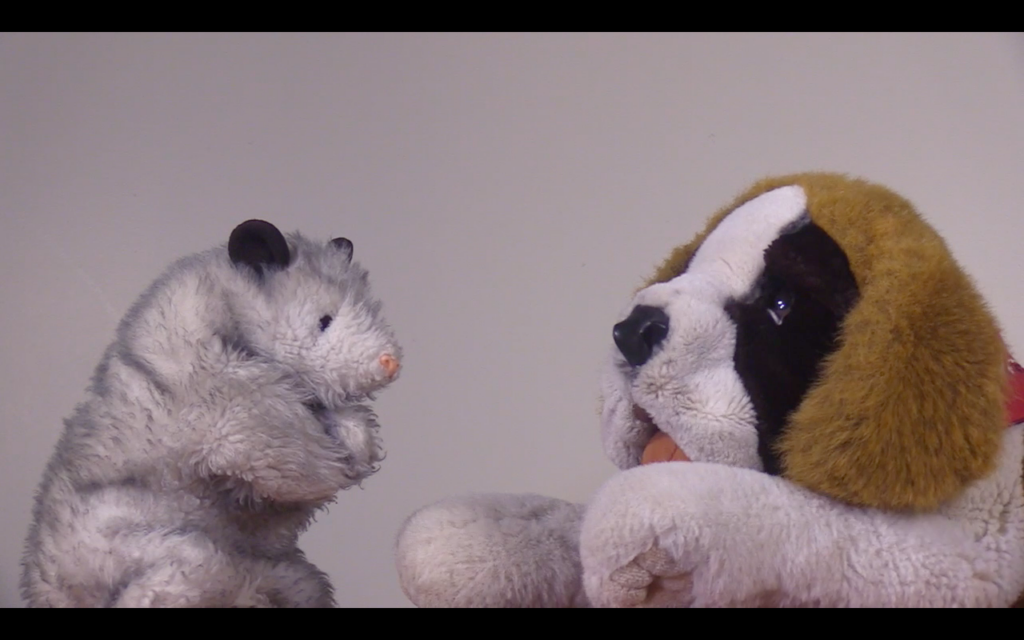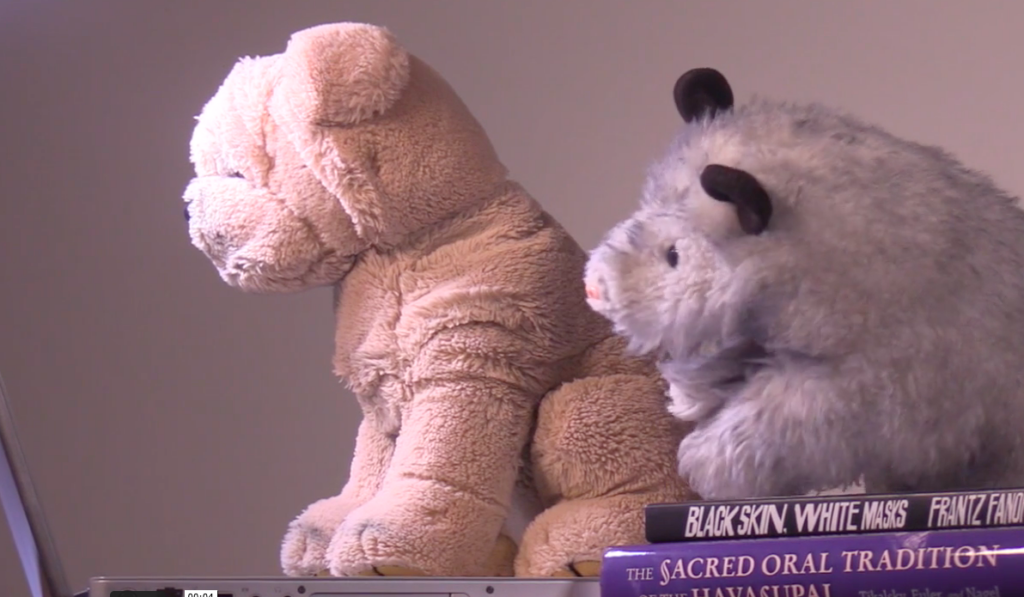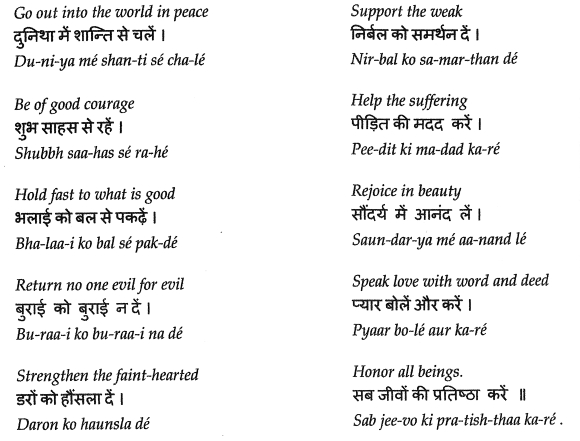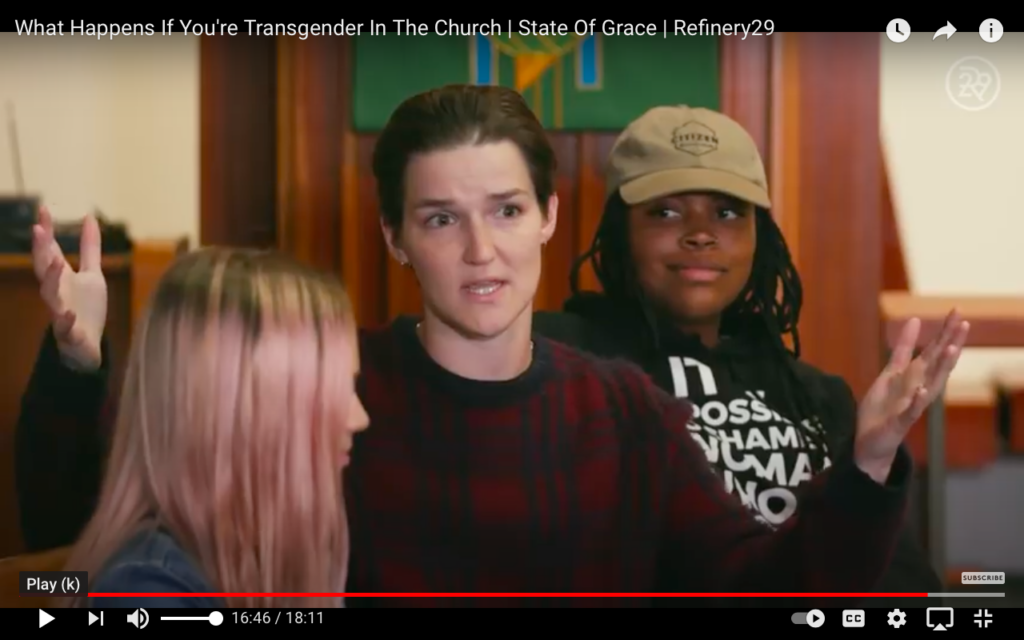Rolf and Possum want to donate to their congregation’s pledge drive. Problem is, they don’t have any money. Then Rolf comes up with an idea….

As usual, full text below the fold.
Continue reading “Possum and Rolf and the pledge drive”Yet Another Unitarian Universalist
A postmodern heretic's spiritual journey.
Rolf and Possum want to donate to their congregation’s pledge drive. Problem is, they don’t have any money. Then Rolf comes up with an idea….

As usual, full text below the fold.
Continue reading “Possum and Rolf and the pledge drive”Possum asks Dr. Sharpie about the meaning of Christmas. Then Possum asks some of his other housemates, and Muds finally helps him find the meaning of Christmas.

As usual, full text is below the fold.
Continue reading “What’s the meaning of Christmas?”In the conclusion to the “Thanksgiving with Family” series, Muds and Possum talk over the Thanksgiving dinners they had with their relatives. For both of them, it didn’t go as badly as they had feared!
As usual, full text is below the fold.
Continue reading “Thanksgiving with family, pt. 3”Dr. Sharpie, Rolf, Ms. and Mr. Bear, and Elephant share Thanksgiving dinner together. They wonder how Thanksgiving dinner went for Muds and Possum. Just then, Muds and Possum come home….
As usual, full text is below the fold. Part 3 coming soon.
Continue reading “Thanksgiving with family, pt. 2”Muds and Possum are worried about going to visit relatives at Thanksgiving, because of uncomfortable conversations with relatives who have differing opinions about climate change, gender, and religion….
As usual, full text is below the fold. Go to Part 2.
Continue reading “Thanksgiving with family, pt. 1”An interesting new children’s book of Bible stories is being funded on Kickstarter. The goal: a kid’s book that’s gender-balanced. Why? Because for the majority of children’s Bible story books, “female characters are vastly underrepresented in both the stories and the illustrations.” The illustrations are also going to show racially diverse characters. Admirable, and I look forward to seeing the book — which sadly won’t be published till 2023.
The old Unitarian Universalist “Timeless Themes” stories, while not completely gender-balanced, had pretty good representation of women. It would be fun to update that with some multi-racial illustrations. And wouldn’t it be nice if we had a UU children’s book of Bible stories that recognizes that God is non-binary gender? Uh huh, that’s what it says in Genesis 1:27: “So God created humankind in his image, in the image of God he created them; male and female he created them.” Ignore the pronouns (nobody remembers ask ask God what their pronouns are), and it’s pretty clear that all genders are created in God’s image.
Go out into the world in peace
Be of good courage
Hold fast to what is good
Return no one evil for evil
Strengthen the faint-hearted
Support the weak
Help the suffering
Rejoice in beauty
Speak love with word and deed
Honor all beings.
Vete en paz al mundo
Mantén tu valentía
Sostén lo bueno con firmeza
No pagues maldad con maldad
Fortalece a los frágiles de Corazón
Apoya a los débiles
Auxilia a los que sufren
Goza de la belleza
Expresa amor con palabra y acción
Honra a todos los seres.
Gehe mit Frieden in die Welt hinaus
Sei guten Mutes
Halte fest das Gute
Vergelte nicht Übel mit Übel
Staerke die Zaghaften
Unterstuetze die Schwachen
Hilf den Leidenden
Erfreue dich des Schoenen in der Welt
Gib Liebe mit Wort und Tat
Ehre alles Dasein.

Ga in vrede de wereld in
Heb goede moed
Houd vast aan wat goed is
Vergeldt niemand kwaad met kwaad
Versterk de krachtelozen
Steun de zwakkeren
Help hen die lijden
Verheug u in schoonheid
Spreek liefde met woord en daad
Eer alle wezens.
I’ve been looking — for quite a while now — for a teaching resource of some kind that shows how some Christians and some Christian groups do in fact support persons of non-binary gender.
The anti-LGBTQ+ Christians are loud and vocal, and they dominate both media and the popular imagination. But I know there are plenty of progressive Christians who feel their religion is fully compatible with being LGBTQIA+. Unfortunately, as is so often the case in our society, most people think it’s a zero-sum game, so the loudest group gets to take charge of the discourse. In addition, as is so often the case in our religiously illiterate society, everyone seems to assume that all religions are monolithic; everyone assumes that one Christian group gets to represent all Christian groups everywhere, ignoring the fact that Christianity has tremendous internal diversity.
As a religious educator, I’ve long tried to teach people both about Christianity’s internal diversity, and about how some Christians are fully supportive of LGBTQIA people. But in a the context of our zero-sum-game, religiously-illiterate society, I haven’t had much success. I kept thinking: If only I had some great teaching resource that showed how some Christians do not have a binary understanding of gender.
So I was pleased to discover this video, which profiles several interesting non-binary Christians. The interviewer, Grace Selmer Baldridge, happen to be a non-binary Christian, which I think makes this video especially powerful. I could wish that Grace Baldridge had been able to interview some non-white non-binary Christians, but aside from that weakness, the interviewees are diverse in their gender identity, in their age, in their expression of their Christianity.
This video may not work well as a teaching resource for those Unitarian Universalists who suffer from anti-Christian bias. Nevertheless, I’m thinking this video could be a great teaching tool for showing both the internal diversity of Christianity, and showing how some Christians believe their religion calls them to a non-binary understanding of gender.

To whet your appetite, here are some quotes from the video:
“We just have to be honest that using the pronoun ‘he’ for God is a habit, but it has no theological justification.” — Dr. Lizzie Berne DeGear, independent scholar
“When I imagine a trans child coming to understand, ‘I might be a girl in this boy body,’ I’m like, ‘Thank you, God, the child is becoming aware of who they really are.’…. God creates out of love. God creates love out of love. We who are in the image of God are all awesome. So when I’m talking to you, I’m learning a little more about God. Because you’re in God’s image. And when you’re talking to me, the same is true.” — Rev. Dr. Jacqueline J. Lewis, senior minister, Middle Collegiate Church
“As a church, we said: We’re publicly going to affirm the LGBTQIA community. We don’t have to be uniform in that belief right away, we can question it, we can disagree, but this is the stance our church is going to take from here on out.… We lost lots of people. We lost thousands of dollars. And it was such a good move. We can sit here and be comfortable, and say OK, the money’s still rolling in and there’s a lot of people coming through my doors, and we can feel good about that. But when there’s literally people out there who are told that they’re not loved, people whose families are disowning them for this, we need to step up and become safe spaces.” — Jonathan Williams, former lead pastor, Forefront Church, Brooklyn, and son of a trans woman
“We really feel that the only way we can combat that negativity [about LGBTQIA people] is with people of faith standing up and saying: No, this is actually not in alignment with how we understand our faith, that you can be Christian and trans, and you can be Christian and gay, and that they’re not mutually exclusive.” — Jamie Brusesehof, mother of a trans child
I just updated the selection of games on my curriculum Web site. In-person games now either have adaptations to make them COVID-safe, or they’re clearly marked “not suitable for COVID.” There’s also a modest selection of field-tested online games for online classes and groups. There are games for all ages from school-aged children up to adults. These games can be used in Sunday school classes, youth groups, adult classes, and other small groups.
Games Web page with COVID-safe games and online games.
We’ve now been teaching my Neighboring Religions curriculum online since March, 2020. This curriculum has transferred extremely well to online teaching. Now I’m writing out the adaptations that we’ve used to make it work so well.
Neighboring Religions curriculum with online adaptations.
If you have any feedback or comments about either the games, or Neighboring Religions, please leave them here.
Another story for liberal religious children. This story comes from Hausa Folklore, stories told by Maalam Shaihua and translated by R. Sutherland Rattray (Clarendon Press, 1913). The Hausa, who live in what is now Nigeria, were one of North Africa’s major trading powers. By the 14th century, many Hausa people had converted to Sunni Islam, and eventually Hausaland became a Caliphate. Traditional Hausa religion (called “Bori” or “Maguzanci”) persisted in the countryside, and still does today. The present story appears to combine elements from older Hausa folklore (talking animals) with Islamic elements (trip to Mecca). This story reminds us that Islam has been a feature of West Africa for centuries.
A certain doctor, a man of great learning who wrote elegant Arabic script and who was well-versed in the complicated legal, historical, and religious learning of the Hausa people, set out to go on the Hajj. This is the pilgrimage to Mecca that all good Muslims hope to make, so that they might add to their rewards in the afterlife.
This doctor had a very thin mare. He saddled her, mounted her, and began the long journey to Mecca. He was deep into the forest when be saw a hyena. The hyena saw that the doctor’s mare was very weary.
“Doctor, where are you going?” said the hyena.
The doctor said, “I am going to Mecca.”
“But something seems to be the matter,” said the hyena.
“It is the mare,” said the doctor. “She is weary.”
“Give the mare to me,” said the hyena. “I shall kill her, and eat her up. Then you can mount me and we shall set out to Mecca.”
The doctor said, “So?”
The hyena said, “Yes, it is so.”
The doctor said, “You must not deceive me.”
She replied, “Come now, Doctor, it is because I have seen that your mare is unable to go on that I speak. For my part, if you mount me, this instant I will carry you to Mecca.”
The doctor said, “All right, catch the mare and eat it.”
The hyena seized the mare, tore it up, picked up the meat and took it home. She ate it with her children. The doctor waited and waited for her to return, but she did not come back. At last a jackal came along and saw the doctor sitting there.
“Doctor, what has happened?” said the jackal.
“I was on my way to Mecca,” said the doctor. “My mare got tired, so I sat down. The hyena came along and asked what was the matter, and I said that that I was on my way to Mecca but my mare was tired.
“And the hyena said, ‘Oh, this thing can never take you to Mecca. Give her to me to eat so I can increase my strength, then I can carry you to Mecca.’ I then said,” the doctor went on,, “‘Hyena, you must not deceive me, by eating my mare then running away.’ But she replied, ‘Why would I do that? it is the truth I told you.’ I thought what she told me was true, but after she caught the mare she went off and I haven’t seen her again.”
“Stop worrying, Doctor,” said the jackal. “I will bring her to you.”
The jackal took up all the horse tack — the saddle and saddle-cloth, the bit and halter, the spurs and whip — and off he went. On the way, he found a lump of meat and took it along as well. He dropped the tack, piece by piece, dropping the saddlecloth last of all, when he was near the mouth of the hyena’s hole.
When he got to the hyena’s hole, he stood and announced his arrival.
But the hyena had told her children, “Whoever comes here looking for me, you must say I am not here.” So when the jackal hailed, the children said, “She is not here.”
“Allah curse her, she has no luck,” said the jackal. “Here I have brought her good news, and bad luck prevents her from hearing it. For a cow has died, a very fat one, and I have come to call her and show her. But you say, she is not here. So I will leave.”
Then the hyena said, “Who is seeking me?”
“I am seeking you<” said the jackal. “A fat cow has died, but these children say you are not here. Here, I cut off a big lump of meat and have brought it to you”
“There is no God but Allah!” said the hyena. “You worthless children, I was asleep, but you say I am not here.” And the hyena came out of her hole.
The jackal offered her some of the lump of meat, saying, “Taste it.”
She swallowed the meat, giving none to her children. Then she said, “Let us be off.”
The hyena was eager to get to the fat cow, and she was a long way in front of the jackal. “Here,” said the hyena, “you cannot walk fast enough. Climb up and ride me so that we may go quickly.”
The jackal rode her, and soon they came to the saddle cloth. The jackal said, “Let me spread this thin on your back, for the hair on your back is getting ruffled.” When he had the saddle-cloth on her, he mounted once again and they rode off.
Soon they came to the bit and halter. “Let me lift up this thing and put it in your mouth,” said the jackal. “Perhaps it will be better for me to hold.”
“Put it on quickly and let us get on,” said the hyena. The jackal put on the bit, took hold of the halter, and they rode off again.
Soon they came to the spurs and whip. The jackal dismounted, took up the whip and put the spurs on his feet, and mounted again.
As they drew near where the doctor was waiting, the hyena said, “You must not take this way.” For she did not wish to meet the doctor again, so she took another path. But when they were opposite where the doctor sat, the jackal struck her with the spurs and turned the bit towards the doctor. Then the hyena sprang forward, saying, “Oou, oou.”
The jackal pulled up in front of the doctor, dismounted, and said, “Doctor, behold your debtor. Mount her, and do not get off until you reach where you are going. If you dismount, even at the water, do not take her to a stream of water.”
The doctor replied, “I have heard.” He mounted, and did not dismount until they had ridden all the way to Mecca, over a thousand miles.
When he got to Mecca, his dismounted from the hyena. He asked some children to hold her, saying, “You must not mount her, and you must not take her to the stream.” Then the doctor entered the mosque where they were praying.
But the children did not listen. They mounted they hyena, and rode her to a nearby stream. As soon as she got out of the town, she began to gallop into the bush. She threw them off, and ran away. So when the doctor came out of the mosque, he saw neither the children, nor the hyena.
That is all.